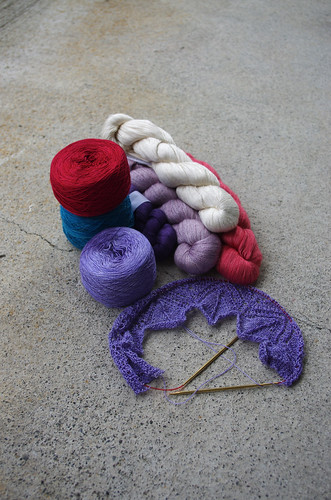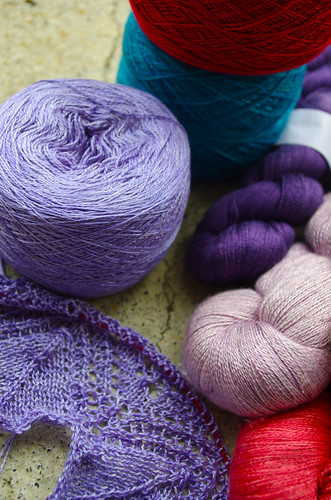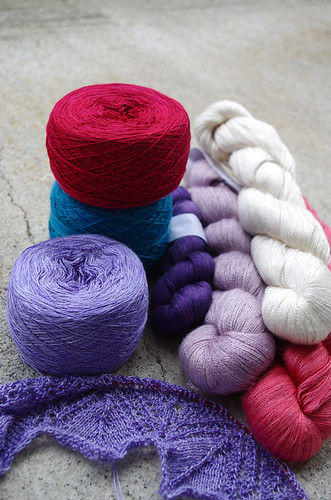Over the last few years, I've accumulated a bit of a laceweight silk stashette, a sort of stash-within-a-stash of this miniature, shiny stuff. You can tell that I gravitate towards purples and strong, saturated colors - except for the cream, which was so jaw-droppingly gorgeous that I bought it despite my lukewarm feelings on shades of white. I already know that I love working with silk blends, since my favorite lace knitting experiences have been with merino/silk blends, but these pure silk yarns are still a bit up on the pedestal for me.
And why not? They're beautiful. Just barely variegated, with a sheen that smacks of royalty. These yarns are high-maintenance to work with, but will reward you with a gorgeous product. I just have to get over my fear of taking them out of their perfect little yarn cakes, because man, they're stunning when they're knit up.
So the other day I decided that since I already had three of these yarns wound up and paired with patterns, that I would cast on with one of them. The pattern for the violet is called Anthemion, a Miriam Felton pattern published in Knitty a few years ago. I cast on and was merrily knitting along when I realized that I had skipped about 10 rows of patterning by accidentally skipping a row of text in the written pattern. Whoops. But I'm fine with ripping it out and starting over, because along the way, I figured out a few things about silk that made it much nicer to work with.
Here's some tips for working with laceweight silk:
1. Keep your hands clean. This is only partially to protect the yarn - I've found that silk moves much more smoothly through clean, dry fingers.
2. On that same note, make sure that your fingernails and skin are smooth. Silk fibers are very fine, and like to snag on even the smallest of rough spots.
3. Use pointy needles. Whether you're doing stockinette or complicated lace with nupps, using pointy needles helps you maneuver those tiny stitches with ease. It doesn't matter if they're bamboo or metal - use what you like! - but since very fine silk is unlikely to be split by a sharper needle, get them as pointy as you can.
4. Use a delicate touch. Silk is strong but prissy. It prefers to be gently nudged down the needles as you're working, rather than shoved.
5. Relax, and keep a loose tension. Silk doesn't have the bounce-back qualities of wool, so you have to give it a little extra breathing room.
Here's hoping that I can follow my own advice and cast on again this week!
Here's hoping that I can follow my own advice and cast on again this week!




No comments:
Post a Comment